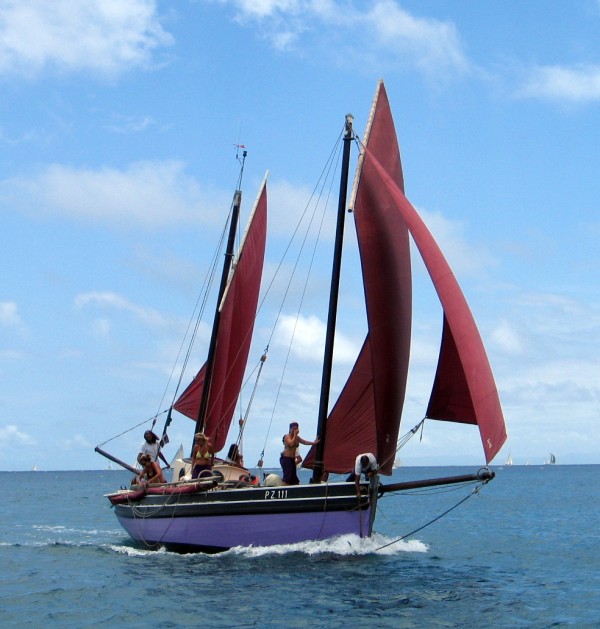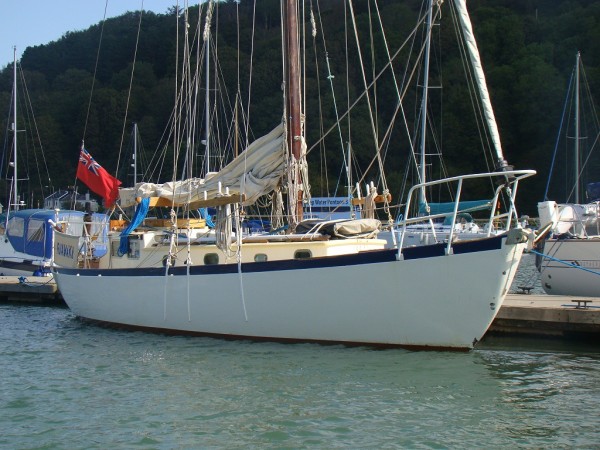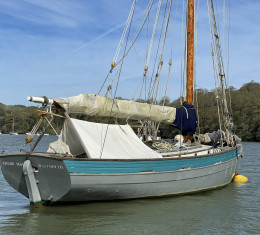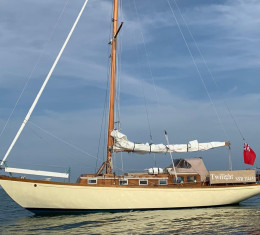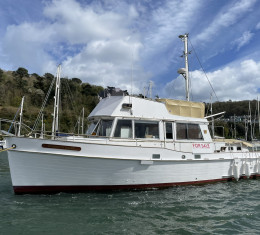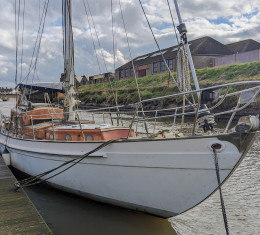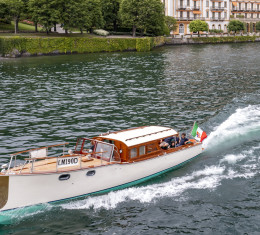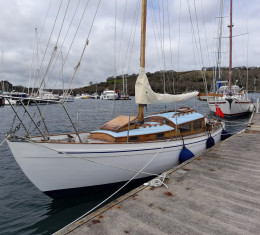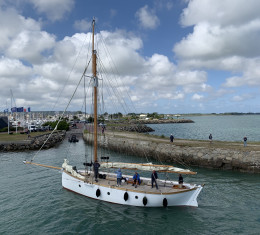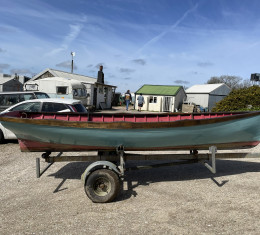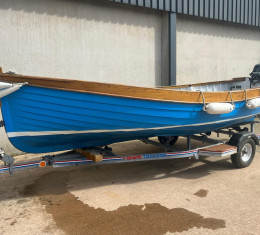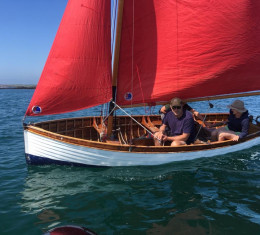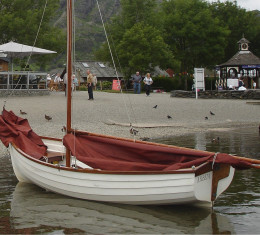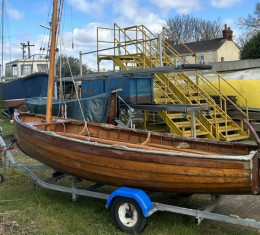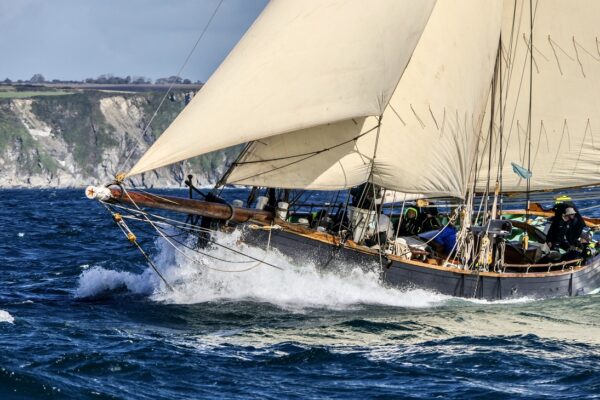Wooden ships comments on this Sean MacMillan Gaff cutter
Now sailing south to Ipswich, ready for inspection. An interesting and recent yacht in exceptional condition, huge cabin, very manageable. This is not expensive for the quality.
Designed by Sean McMillan.
Built by McMillan Yachts of Snape, Suffolk for the previous owner in 1992.
McMillan Yachts built a number of these yachts and now builds the Spirit range of yachts in Ipswich using the same proven construction techniques..
The yacht was in first ownership from build to 2007, lived on the Clyde, sailed every season and was stored under cover every winter October to April. She cruised the West Coast of Scotland and the Hebrides and has inevitably experienced her share of bad weather, never causing her pensioner owners any concern and giving better than expected windward performance for a gaff cutter.
Sold by Wooden Ships in July 2007 to the present owner and remained on the West Coast of Scotland, sailing every summer from her mooring on the Isle of Sky and wintering ashore under cover, mast out.
She is presented in very good condition, fully equipped and ready to sail.
The design is traditional on deck but with a modern yacht profile below the water and features a good beam, long keel with interesting cut-away fore foot, a knuckle at the water-line to a straight stem and a wide, slightly raked and radiussed transom stern.
Good freeboard, the topsides finished in immaculate varnish.
Low profile coach-roof with an interesting design showing a slight Dutch influence with an eye-catching upward sweep to the roof incorporate the entrance hatch aft.
The generous beam allows a wide coach-roof while still leaving safe wide side decks.
Spacious, deep cock-pit with radiussed after end, tiller steering on transom-hung rudder.
Construction.
The hull is built with edge-glued strip plank 15mm x 44mm convex/concave edges glued with epoxy glue and edge fastened with bronze Gripfast nails, overlaid with 3 layers of mahogany veneer on the outside, 2 layers double diagonal 3mm mahogany epoxy bonded + one layer horizontal 5mm mahogany following the sheer line and finished with Epiphanes varnish.
Below the wl she has 3 layers of diagonal 3mm mahogany on the strip planking + a layer of epoxy and glass cloth and anti-fouled.
10mm and 12mm internal laminated ring frames.
The back-bone is built up in laminated iroko including deck shelf and floors.
External long iron ballast keel secured with stainless steel bolts through the floors.
Ash deck beams. Planked, varnished ash deckhead
Bulkheads in 12mm and 18mm marine ply epoxy bonded to the structure.
Carlins and coamings to the coach-roof and cock-pit are in solid mahogany and finished varnished.
The deck is in yacht laid scrubbed teak over a mahogany ply layer over10mm white ash to give a planked look from below.
Seams payed with polysulphide rubber.
Teak toe rails and rubbing strake finished scrubbed.
The coach-roof deck is built in the same way as the main weather deck and fitted with grab rails each side. 3 windows each side in the coach-roof coamings, traditional varnished mahogany sky-light with opening lights.
A low-profile, off-set fore hatch with bull’s eye light on the fore deck, also teak laid with varnished mahogany coaming.
Laminated iroko rudder epoxy glass sheathed, stainless steel pintles in bronze bushes. Laminated tiller. Self draining cock-pit.
Bronze and stainless steel deck fittings. Bronze stemhead fitting with single chain roller. Twin bitts on the fore deck take the heel of the stbd off-set bowsprit and serve as mooring bitts.
2008 New pulpit and raised stanchion posts and safety lines fitted.
2010 New fairleads fitted fore and aft.
Rig
Gaff cutter on varnished, round section hollow Sitka spruce mast stepped on the forward end of the coach-roof. Internal wiring for nav lights etc
Slab-reefing boom, gaff and bowsprit all in solid, varnished Sitka spruce and finished varnished.
The boom with jammer lower block sheets to a horse on the transom over the tiller and when the mainsail is not set rests in a fixed, 3-position timber gallows mounted on bronze posts.
Rigging
Stainless steel standing rigging with stainless steel rigging screws to external bronze chain plates.
Running back-stays on tackles.
Topsail set on a varnished yard, sheeted to the outer end of the gaff.
Stemhead staysail and jib to the outer end of the bowsprit both set on Wickham Martin roller gear.
Nov 2010 All sheets and halyards replaced
Winches
1 mast halyard winch.
4 self tailing cock-pit sheet winches.
Sails
All sails by Gale Heard, 1991 in cream terylene.
Mainsail 396.5 sq’ with 3 slab reefs with sail cover.
Staysail 115 sq’ on roller gear.
Jib 116 sq’ on roller gear.
Topsail 81 sq’ on yard.
2009 All sails cleaned and repaired as required
Engine.
Perkins Perama 30hp 3-cyl diesel installed new in 1992 and now with approx 2200 hours.
Hurth single lever control gearbox.
Full instrumentation including hour and volt meter.
Centre-line shaft to 3-blade prop gives her 6knts max.
Consumption estimated at 3 hours per gallon and 2200rpm.
Fuel
10 gall plastic fuel tank port side in the stern locker.
Electrics
3 x 12v batteries located port side midships on 12v circuits. One battery is dedicated to engine start and 2 on domestic supply with split charge relay.
2010 two new domestic batteries.
Accommodation 3 single berths + one double.
The fore peak is given over to stowage and ablutions. Jabsco sea toilet on the centre-line, sail stowage to stbd, porcelain basin in a surface to port with mirror over on the hanging locker door and vanity drawer below. Storage lockers.
Bulkhead to saloon cabin, centre-line panelled door.
Stbd settee berth, shelf behind. Port U-shaped seating with shelf behind. Large double drop-leaf table with glass and bottle stowage in the middle.
Vertical compression post under the mast against the fwd bulkhead. Pascal Atkey charcoal cabin heater in a port recess in the fwd bulkhead lined with ceramic tiles.
Part bulkhead to port with vertical grab post, forward facing chart desk against the bulkhead, seat on the fwd end of the quarter berth which extends well out into the cabin allowing easy access.
Stbd U-shaped galley. Part bulkhead to stbd quarter berth. Vertical grab post.
New 2005 Italian gimballed 2-burner, grill and oven gas cooker with 12v isolator valve.
Double ceramic sinks drain overboard. Work surface. Lockers under
Port and stbd quarter berths extend well out into the cabin allowing easy access.
Centre-line steps to the cock-pit, remove to access the engine.
Stunning interior in all varnished interior fitted out in ash and mahogany joinery. Varnished planked ash deckhead. Varnished hardwood sole boards.
2009 All new upholstery
6’ head-room all through.
Water
2 x Vetus flexible 100 litre water bags under the settees. In-line water filters. Hand pumps at the galley sink and the forward sink.
Equipment.
Sestral binnacle compass.
Silva hand bearing compass.
Raymarine ST50 sounder
Raymarine ST50 log (thru hull)
Raymarine C70 chart plotter
Simrad RD68 DSC VHF radio, new 2007.
Vtronix Great Hawk windvane self steering + spare
New 2009 Tacktick wind indicator.
2011 AIS transmit and receive.
15kg Bruce bower anchor + 70 meters 5/16”b chain.
16Kg fisherman anchor + 8 meters 5/16” chain.
2009 12v Lewmar Electric Windlass with remote
4 life jackets with 2 safety harneses
Horse-shoe life buoy
2 fire extinguishers
1 automatic fire extinguisher in the engine space
Off-shore flare pack.
2009 McMurdo EPIRB
2008 Zodiac life raft, rearmed 2011
Compass 3-man inflatable dinghy
Grasshopper 3-man collapsible dinghy
Mariner 2 ½ HP outboard engine
2 x 5 meter mooring warps.
15 meter spring
2 x 16 meter mooring warps.
7 fenders with socks
1 inflatable defender
Manual and electric bilge pumps
4 x 10L diesel cans
12v dinghy inflator
Handy Billy tackle
Collapsible outboard engine hoist
10’ boathook
2010 Aquasignal masthead tri-colour LED nav lights.
Numerous charts, W Coast Scotland, Hebrides etc.
Cock-pit cover.
A rare, recent yacht in immaculate condition, stored under cover every winter, annually varnished and well maintained.
The volume in the cabin of this yacht has to be seen to be believed, surprising every visitor given her length.
The cock-pit is wonderfully shaped, safe, deep and sheltered so that a spray-hood is not required.
The rig is well proportioned and easily worked from the wide safe clear deck and her performance surprises many modern yacht owners.
First owners sold and retired after 16 years very happy, trouble-free years sailing.
She was a second boat for her current owners and has been such a great success they are now selling to build a new larger version.
The yacht is offered for sale, fully equipped, fitted-out and ready to be launched for next season.
A 2009 Oceancover Titanium boat tent, 10m x 4m is available at additional cost by negotiation.
Disclaimer:
These particulars have been prepared in good faith from information provided by the Vendors and are intended as a guide, Wooden Ships cannot guarantee or warrant the accuracy of this information nor warrant the condition of the vessel. The Purchaser should instruct his agent or surveyor to validate all details as necessary and satisfy himself with the condition of the vessel and its equipment.






